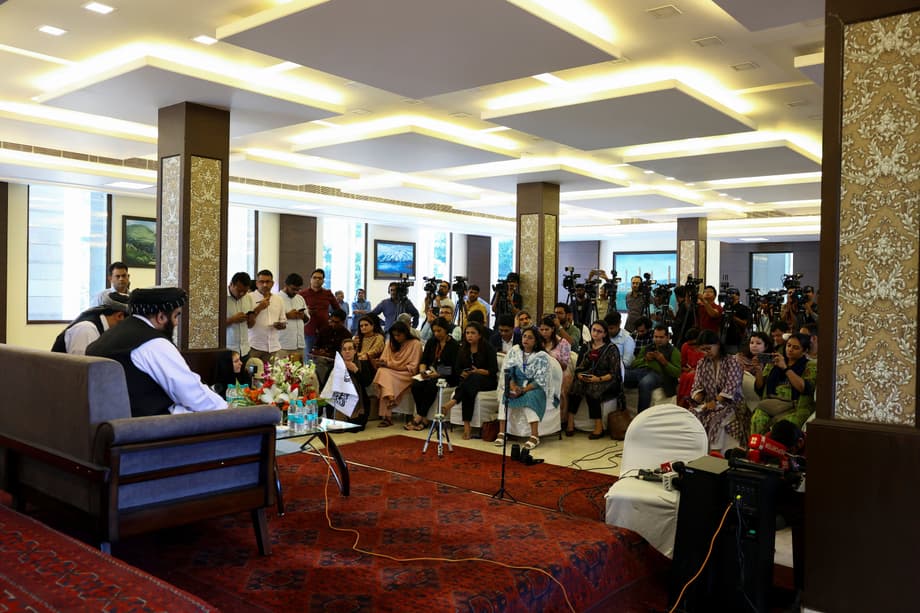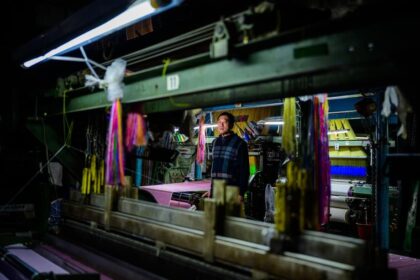A rare confrontation in Delhi
Three days after being shut out of a scheduled media event, women journalists walked into the Afghan embassy in New Delhi and took the front rows. They were there to question Amir Khan Muttaqi, the Taliban foreign minister, about the erasure of Afghan women from schools, workplaces, and public life. The moment, captured by cameras, cut against the image of an all male administration and against the protocol of the first press meeting of the visit, where only men had been admitted. The women pressed their case in public, and they did so in the capital of a country that presents itself as a champion of press freedom and gender equality.
Muttaqi is on a week long trip to India, his first foreign mission of this scale since the Taliban reclaimed power in 2021. The visit is intended to signal a thaw between Delhi and Kabul and to build contacts that the Taliban can point to as steps toward international acceptance. The outreach stumbled on arrival. At the embassy on Friday, women reporters who cover foreign affairs were denied entry while male colleagues attended. Indian press bodies and opposition politicians called it a violation of Indian norms. The episode triggered a question that rippled beyond the press room, whether a visiting delegation should be allowed to import gender exclusion into India.
By Sunday the approach had changed. Women journalists received invitations, entered without being told to cover their hair, and were given seats up front. The switch followed a wave of public criticism. It came amid wider moves that framed the week as a diplomatic reset. After meetings between Muttaqi and External Affairs Minister Subrahmanyam Jaishankar, India said it would upgrade its presence in Kabul from a technical mission to a full embassy. The Taliban delegation is under United Nations sanctions, so the foreign minister traveled under a Security Council waiver that permits limited trips for official business.
What changed between Friday and Sunday
Journalists who attended both briefings said the backlash mattered. Colleagues shared contact lists, pressed for inclusion, and pledged solidarity. At the second event male reporters stood aside to let women occupy the front rows. Inside, the tone was brisk and direct. Questions focused on education bans, work restrictions, and the credibility of the Taliban leadership when measured against its own public statements. The minister fielded several rounds without the constraints he imposes at home, a rare scene for Afghan women who have been kept off air, off campus, and off the street.
Inside the second press conference
Prominent independent journalist Smita Sharma set the tenor with a plain question that echoed what many Afghan families have been asking for years.
“Why are you doing this in Afghanistan? When will they be allowed to go back and get the right to education?”
Pressed on the exclusion of women from the first event, Amir Khan Muttaqi, the Taliban foreign minister, said it was a matter of logistics rather than design.
“It was organised on short notice. A short list of journalists was invited. It was a technical issue, there were no other problems.”
He then offered a defense of the record on schooling and participation.
“We have 10 million students attending schools and other educational institutes, of which 2.8 million are women and girls. In religious seminaries, this educational opportunity is available all the way to graduation. There are certain limitations in specific parts, but that does not mean we oppose education.”
Those claims clash with conditions inside Afghanistan. Girls remain barred from secondary and higher education nationwide, and most women are blocked from professional life. Even where short courses exist in religious institutions, they do not replace accredited schooling or university degrees, and they do not reopen pathways to employment that have been sealed shut. Inside the room in Delhi, the skepticism was palpable.
Press freedom and gender on Indian soil
The initial exclusion drew censure from Indian media bodies and raised alarms about precedent in the world’s largest democracy.
The Press Club of India said a visiting delegation cannot set discriminatory terms for access.
“We strongly condemn the exclusion of women journalists and call on the government to ensure that no foreign power is permitted to dictate the terms of engagement with the Indian press.”
The Editors Guild of India framed the incident as a violation of equal access.
“This is blatant gender discrimination on Indian soil.”
The Ministry of External Affairs said it had no involvement in the embassy press interaction. To many in the profession that answer felt inadequate. Suhasini Haider, Diplomatic Editor of The Hindu who attended the second briefing, described her first reaction and the concern about precedent.
“Our first response was outrage. We had hoped the government would at least say something. The idea that a representative of the Taliban, a government not recognized by India, could come to Delhi and host a press conference without women should never become a precedent.”
Opposition politicians accused the government of silence and of allowing discrimination in the capital. Some called on male reporters to stage a walkout. Others demanded a public clarification from the Prime Minister and the foreign ministry. The message from critics was straightforward. Equal access for women journalists is not negotiable in India.
What the Taliban policy means for Afghan women and girls
Afghanistan today is the only country where girls and women are barred from general secondary and higher education. Decrees and directives regulate dress, travel, and work. Women cannot travel long distances without a male guardian. Many public places that once welcomed women, from gyms to parks to beauty salons, have been closed to them. Professional roles that once offered careers, including civil service and many fields in health care, have withered under sweeping bans and intimidation.
United Nations experts and rights advocates have described the system as gender apartheid, a term used to capture the intentional separation and subordination of women. In July this year, the International Criminal Court sought arrest warrants for two senior Taliban figures, citing the persecution of women and girls as evidence of crimes against humanity. The cases, if confirmed by judges, would reinforce the message that the issue is not a matter of culture alone, but of international criminal law.
For Afghan families the costs are immediate. Teenage girls have lost years of schooling. University students have been sent home. Female employees in many sectors have received orders to stay away. Aid organizations have struggled to operate when female staff are barred, and health outcomes suffer when women cannot see female professionals. The policy is not a pause, as officials sometimes claim. It is a living reality that shapes everyday life.
Afghan media and the silencing of women
The media landscape has contracted sharply since August 2021. Surveys by press freedom organizations found that 231 outlets shut within months of the takeover, a drop of more than four out of ten from the pre August total. The number of people working in Afghan media fell by more than half, and women suffered the deepest losses. In that early period more than eight in ten women journalists left or lost their jobs, and in many provinces none remain on air.
Restrictions go beyond closures. Reporters describe a climate of permission seeking and fear. A local watchdog documented at least 183 cases of violence and more than 90 arrests in the first year after the takeover, with the vast majority attributed to Taliban forces. Under informal rules, coverage of protests, security and many social topics requires clearance. Female voices are pushed off air, and state media bar women from presenting.
One journalist in southern Helmand province explained what this looks like in practice.
“Before we cover a story, we have to inform the provincial authorities of the topic and get their permission.”
Economic collapse has compounded the damage. International aid and advertising that once underwrote local radio and television have evaporated. Owners cannot pay staff. Newsrooms cut programming and replaced it with religious content, or they shut altogether. The result is less information for the public and even less space for women to be heard.
Why Delhi is engaging the Taliban now
India kept channels to Afghanistan open after 2021 through a small technical mission that facilitated aid and consular services. The announcement in Delhi that this mission will be upgraded to a full embassy marks a deeper level of engagement. The Taliban foreign minister arrived in India on a United Nations travel waiver, since many of the movement’s leaders, including him, remain under Security Council sanctions. The visit allowed face to face meetings with Indian officials and a public relations push with media.
Strategic calculations shape this outreach. India has interests in regional stability, trade routes to Central Asia, counterterrorism cooperation and the safety of its citizens and projects in Afghanistan. Relations between the Taliban and Pakistan are strained, which creates openings that Delhi may see as useful. At the same time, India has not recognized the Taliban as the legitimate government of Afghanistan and says it remains committed to democratic values.
Many governments are in a similar holding pattern. Russia has announced formal recognition of the Taliban. Other countries run embassies in Kabul but stop short of recognition. Diplomats and analysts say progress on women’s rights will be a central measure for any broader acceptance. That linkage was visible in Delhi, where the loudest moment of the visit was a chorus of questions about Afghan girls and women.
What progress would look like
Concrete steps are not hard to list. Reopen secondary schools and universities to girls everywhere, with accredited curricula and real access. Allow women to work in government, media, civil society, health, education and the private sector. End the requirement for a male guardian to travel or access services. Lift the bans on female staff at aid agencies. Restore the right to public life, including safe movement in parks, salons and recreational spaces. Create transparent rules that match Afghanistan’s international obligations and allow independent monitoring.
In India, officials and media organizations are already drawing lessons from the episode in Delhi. Clear ground rules for press interactions with visiting delegations would help prevent any repeat of gender based exclusion. The women who took their seats at the Afghan embassy showed that solidarity can move a line. The hardest tests remain inside Afghanistan, far from a microphone in New Delhi.
At a Glance
- Women journalists were barred from a Friday embassy press event in Delhi, then invited to a second briefing on Sunday where they questioned Taliban foreign minister Amir Khan Muttaqi.
- Indian media bodies condemned the initial exclusion as gender discrimination. The Ministry of External Affairs said it was not involved in the embassy event.
- Muttaqi called the exclusion a technical issue and claimed millions of female students are enrolled. Reporters challenged these assertions against nationwide bans on girls’ secondary and higher education.
- India said it will upgrade its technical mission in Kabul to a full embassy after meetings with the Taliban delegation, which traveled under a UN Security Council waiver.
- Afghanistan remains the only country with a blanket ban on general secondary and higher education for girls. UN experts describe the system as gender apartheid. The ICC sought arrest warrants in July for Taliban leaders over persecution of women and girls.
- Surveys show a collapse of Afghan media since 2021, with hundreds of outlets shut and more than eight in ten women journalists pushed out of work. Reporters face arrests, violence and pervasive censorship.
- Russia has recognized the Taliban. India has not, and many countries tie any future recognition to measurable improvements in women’s rights and basic freedoms.












